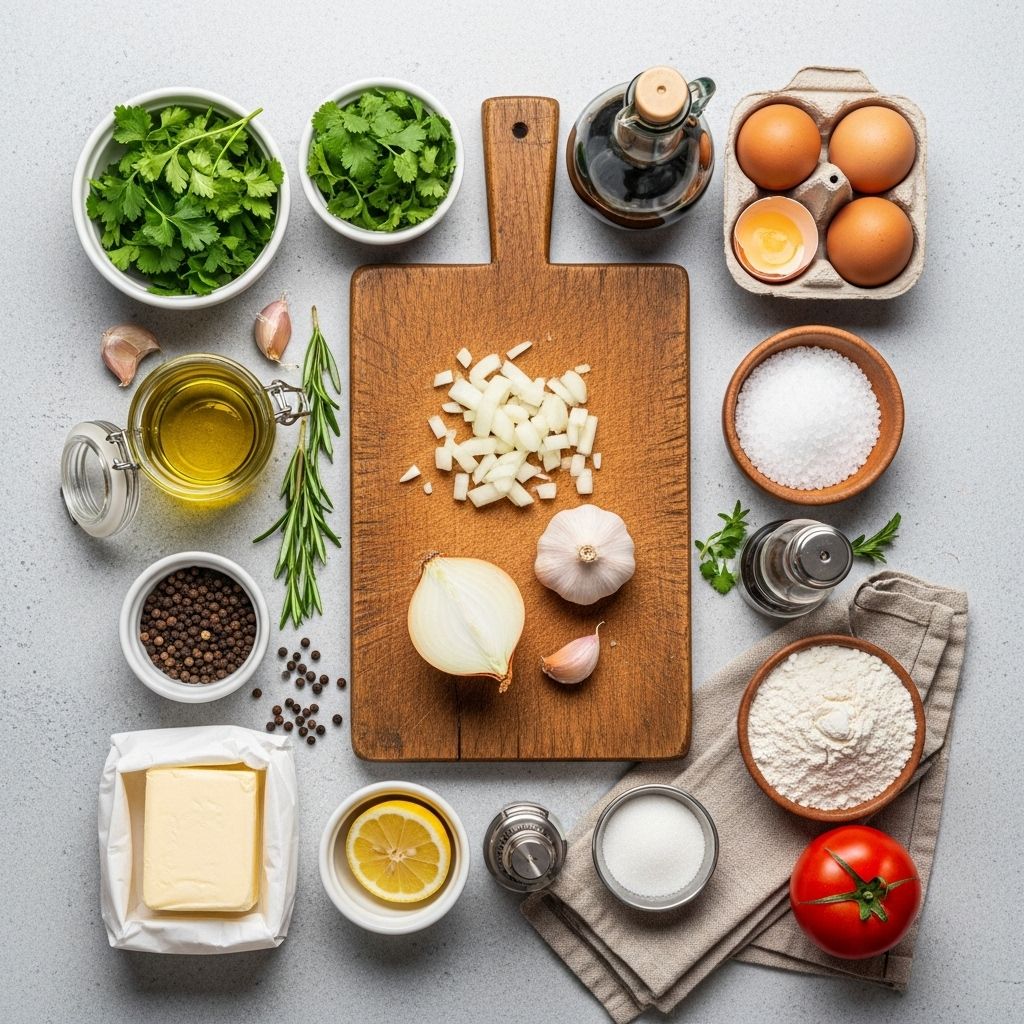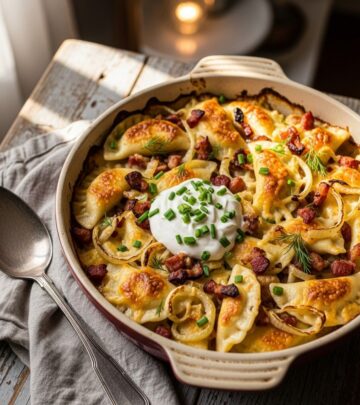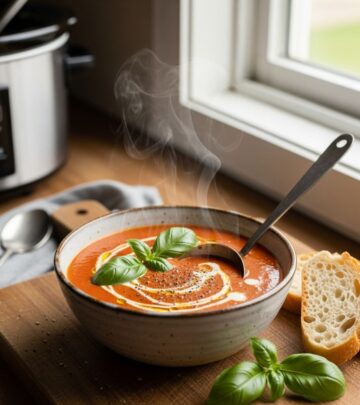Essential Cooking Ingredients: A Comprehensive Guide for Every Kitchen
Discover the fundamental ingredients, their uses, storage tips, and expert advice for building a well-stocked kitchen pantry.

Essential Cooking Ingredients: The Backbone of Every Great Recipe
Behind every delicious meal lies a set of well-chosen ingredients. Whether you’re a novice cook or an experienced chef, understanding which ingredients are fundamental, how to use them, and how best to store them will help you cook with confidence and creativity. This guide provides an in-depth look at the most essential ingredients, organizing them by type, with practical kitchen tips along the way.
Table of Contents
- Pantry Staples
- Baking Ingredients
- The Spice Floor: Herbs & Spices
- Dairy & Eggs
- Sweeteners
- Fats & Oils
- Fruits & Vegetables
- Proteins: Meat, Poultry, and Alternatives
- Ingredient Substitutions
- Tips for Shopping & Selecting Ingredients
- Storing Ingredients for Freshness
- Frequently Asked Questions
Pantry Staples: The Building Blocks
Having a well-stocked pantry means you’re always just a step away from creating a satisfying meal. These core pantry staples are foundational across countless global cuisines:
- Flour: All-purpose flour is incredibly versatile, used for baking breads, cakes, cookies, and as a base for thickening sauces and gravies. Whole wheat, bread, and specialty flours like rye or almond expand your options.
- Sugar: White sugar is a universal sweetener, but brown sugar, powdered sugar, and alternative sweeteners each bring unique flavors and textures.
- Salt: Table salt, kosher salt, and sea salt are essential for seasoning and drawing out the natural flavors in food.
- Rice & Pasta: Both are staple carbohydrates that act as the foundation for many dishes.
- Canned Goods: Stock up on beans, tomatoes, vegetables, and coconut milk for quick meals and soups.
- Oats & Grains: Rolled oats, quinoa, barley, and polenta are ideal for breakfast and wholesome sides.
- Baking Powder & Baking Soda: These leaveners are crucial for giving baked goods the desired rise and texture.
- Vinegar: White, apple cider, balsamic, and rice vinegars are key for salad dressings, sauces, and pickling.
- Broths & Stocks: Chicken, beef, and vegetable broths add depth of flavor to soups and stews.
Baking Ingredients: Sweet and Savory Perfection
Baking is both an art and a science, and it relies on precise combinations of ingredients. Here are the classics every baker needs:
- Flour: The backbone of most baked goods. Always keep both all-purpose and cake/pastry flour handy if you bake often.
- Sugar: White (granulated), brown, and powdered sugars all produce different results in baked recipes. Brown sugar adds rich caramel notes, while powdered sugar is perfect for icings and dusting.
- Baking Powder & Baking Soda: These are not interchangeable, so check your recipe!
- Yeast: Perfect for making breads, rolls, and some pastries.
- Cocoa Powder: For chocolate-flavored cakes, brownies, and cookies.
- Cornstarch: Thickens custards, puddings, and sauces—also tenderizes cookies and cakes.
- Extracts & Flavorings: Vanilla extract is the most common, but lemon, almond, and other extracts can add variety.
- Shortening & Butter: Essential for creating flaky textures in pie crusts and tender cakes.
The Spice Floor: Herbs and Spices That Elevate Flavor
A world of flavor comes from the spice rack. Spices can dramatically change the character of a dish, offering warmth, heat, freshness, and aroma. Here are some of the most common and impactful:
| Spice/Herb | Common Uses |
|---|---|
| Black Pepper | Universal seasoning, pairs with meats, vegetables, eggs |
| Garlic | Foundational for savory dishes, used fresh or as powder |
| Onion | Bases for soups, stews, sauces, and marinades |
| Basil | Italian, Southeast Asian cuisines, salads |
| Oregano | Pasta sauces, Mediterranean dishes |
| Thyme | Poultry, soups, stews |
| Paprika | Stews, roasted meats, garnish |
| Cinnamon | Baked goods, oatmeal, curries |
| Cumin | Tex-Mex, Indian, Middle Eastern dishes |
| Chili Powder | Spicy dishes, rubs, stews |
According to a large data analysis, salt, sugar, eggs, butter, water, flour, garlic, onion, and black pepper are the most frequently used ingredients in recipes. Spices alone comprise over 13% of all ingredients used, with garlic and black pepper being especially prominent.
Dairy & Eggs: Creaminess and Structure
- Milk: Cow’s milk is most common, but plant-based alternatives like almond, soy, and oat milk work for many recipes.
- Cream and Half-and-Half: Adds richness to sauces, soups, desserts, and coffee.
- Butter: Preferred for baking and sautéing; imparts flavor and texture.
- Cheese: Mozzarella, Parmesan, Cheddar, and Feta are versatile choices, balancing flavor and melting properties for many dishes.
- Eggs: Essential for binding, leavening, and adding moisture to baked goods and for creating custards, quiches, and more.
- Yogurt & Sour Cream: Useful for marinating, dips, baking, and as tangy toppings.
Sweeteners: More Than Just Sugar
Sweeteners not only provide sweetness but also impact texture, color, and flavor:
- White Sugar: Standard for most baking and cooking.
- Brown Sugar: Adds moisture, caramel notes, and color to baked goods.
- Honey & Maple Syrup: Natural alternatives with their own distinctive flavors.
- Molasses: Used in gingerbread and some sauces, brings a robust richness.
- Powdered Sugar: Ideal for icings and dustings; dissolves quickly.
Fats & Oils: The Essence of Flavor and Texture
- Olive Oil: Versatile for sautéing, roasting, dressing salads, and finishing dishes.
- Vegetable Oil: Neutral flavor and high smoke point, perfect for deep frying and baking.
- Butter: Adds flavor, moisture, and richness, particularly in baking and sauces.
- Coconut Oil: Adds a subtle aroma to baked goods and vegan recipes.
- Shortening: Creates tender pastries; ideal for pie crusts.
- Sesame Oil: Used for adding a nutty flavor to stir-fries and Asian dishes.
Fruits & Vegetables: Nature’s Bounty
- Onions and Garlic: Ubiquitous bases for flavor in countless cooked dishes.
- Bell Peppers, Tomatoes, and Carrots: Add sweetness, color, and texture to salads, stews, and roasts.
- Lemons & Limes: Used for acidity, zest, and freshness in sweet and savory recipes.
- Potatoes: Boiled, baked, fried, or mashed; they are supremely versatile.
- Leafy Greens: Such as spinach, kale, and lettuce, are essential for salads and sautéed dishes.
- Root Vegetables: Carrots, parsnips, turnips, and beets round out stews, soups, and roasts.
Proteins: Meat, Poultry, Seafood & Plant-Based Alternatives
- Chicken Breasts & Thighs: Lean, widely used, and take on a variety of flavors.
- Beef (various cuts): From ground beef for burgers to roasts and steaks.
- Pork: Chops, loin, and bacon offer unique flavors.
- Fish & Seafood: Salmon, shrimp, cod, and tuna are among the most versatile.
- Eggs: Serve as both a protein source and functional ingredient in baking and cooking.
- Plant-based Proteins: Chickpeas, kidney beans, tofu, tempeh, and lentils for vegetarians and vegans.
Ingredient Substitutions: Adapting with Confidence
Running short on an ingredient needn’t spell disaster. Many ingredients can be swapped with others, preserving the structure and flavor of your recipe:
- Eggs: Substitute with flaxseed meal mixed with water in baking (1 tbsp flaxseed meal + 3 tbsp water = 1 egg).
- Milk: Use water plus a little butter or non-dairy milks such as soy or almond.
- Sour Cream: Greek yogurt can often be used in both baking and sauces.
- Baking Powder: If out, use ¼ teaspoon baking soda plus ½ teaspoon cream of tartar per teaspoon baking powder needed.
- Butter: Try margarine, shortening, or coconut oil when appropriate.
- Honey: Maple syrup or agave nectar are suitable substitutes in most recipes.
Tips for Shopping & Selecting Ingredients
- Shop Seasonally: Fruits and vegetables are cheaper, fresher, and taste better in season.
- Read Labels: Avoid foods with unnecessary additives or excessive sodium and sugar.
- Buy in Bulk: Basics like grains, beans, flours, and rice are often cheaper in bulk and keep well if stored correctly.
- Check for Freshness: Look for bright colors, firm textures, and avoid mold or spots with produce.
- Choose the Right Cut: For meats, different cuts suit different cooking methods. Ask your butcher for advice!
Storing Ingredients: Extending Freshness and Flavor
- Cool, Dry Pantry: Store grains, flours, sugars, pasta, and canned goods away from heat and moisture.
- Refrigerator: Dairy, opened sauces, eggs, cut fruits/vegetables, and leftovers should be kept cold.
- Freezer: Meats, bread, some fruits and vegetables, and herbs can be frozen for extended use.
- Herbs: Store fresh herbs in a glass of water (like a bouquet), cover loosely, and refrigerate. Dried herbs should be kept airtight in a dark cabinet.
- Spices: Whole spices last longer than ground. Keep them away from light, heat, and moisture to preserve their vibrant flavors.
Frequently Asked Questions (FAQs)
What are the most commonly used ingredients in home cooking?
Salt, white sugar, eggs, butter, water, flour, garlic, onion, black pepper, and olive oil are among the most frequently used ingredients according to recipe datasets and kitchen surveys.
How can I build a basic pantry for cooking from scratch?
Focus on versatile staples: all-purpose flour, white and brown sugar, pasta, rice, canned beans and tomatoes, baking powder, salt, pepper, a few dried herbs and spices (like basil, oregano, and garlic powder), olive oil, and basic vinegars. Add fresh or frozen proteins and vegetables as needed.
Are fresh herbs better than dried?
Fresh herbs are generally more aromatic and best for finishing dishes or salads, while dried herbs work well for long-cooked applications like soups, stews, and braised dishes. Use three times more fresh than dried if substituting.
What is the best way to store flour and keep it fresh?
Keep flour in an airtight container in a cool, dry place. For longer storage, particularly for whole grain flours, refrigeration or freezing helps prevent rancidity caused by natural oils.
How can I make my own spice blends at home?
Start by combining dried herbs and spices in ratios matching your favorite store blends, such as taco, curry, or Italian seasoning. Store prepared blends in airtight containers out of direct sunlight for maximized flavor.
Inspiration: Try Something New!
Exploring new flavors and ingredients will keep your cooking exciting and rewarding. Don’t be afraid to step outside your comfort zone. Swap in a new spice, try an unfamiliar vegetable, or create a healthier version of your favorite comfort meal. With the right set of ingredients, your kitchen can become a launchpad for delicious experiments and memorable meals.
Read full bio of Sneha Tete












